The Achilles Heel of the AI Boom
Technology companies are transforming from asset-light to asset-heavy businesses
Special announcement: I’ll be giving a presentation next Thursday with my partner and co-manager in the Blue Orbit Capital Fund, Mario Randholm: “Double, Double Toil and and Trouble… Are We In An AI Bubble?”
We’ll be covering signs that the AI bubble is reaching its climax and explain how we’re positioning ourselves to profit from the blow-off top while also protecting from the inevitable fallout. Registration is free. See you on Thursday!
The Achilles Heel of the AI Boom
Software is a wonderful business once you hit critical mass. You have labor costs to develop the product and write the code and you have fixed costs like office expenses, hardware and ongoing software maintenance and upgrades. But your variable costs are essentially zero. The same piece of software can be copied, sold or licensed an infinite number of times.
It’s the definition of a capital-light business: Minimal investment in physical infrastructure that generates sustained, outsized returns. It’s the stuff that MBA nerds with financial calculators and spreadsheets dream of.
This is why software companies have some of the highest profit margins and returns on equity. Microsoft, for example, has generated returns on equity in the 30-40% range for most of its existence as a public company.
But all of this is changing. As Kai Wu, founder of Sparkline Capital, points out, the massive investment in AI infrastructure is transforming the formerly nimble, asset-light tech giants into lumbering asset-heavy ones.
This makes them fundamentally less attractive… and suggests that investors may be in for disappointment.
Rather than summarize Kai’s excellent piece, I’ve republished it below, edited slightly for length. You can read the original here.
Most value investing is stodgy, boring, and stuck in the past with financial ratios developed a century ago in a very different economy.
Kai’s valuation metrics are different. He’s one of the few analysts I’ve seen that truly knows how to value tech companies, with a strong focus on intangible assets, including intellectual capital, branding and network effects. I interviewed Kai earlier this year, and you can view the interview here.
Now, on to the good stuff…
Surviving the AI Capex Boom
By Kai Wu, Founder and Chief Investment Officer of Sparkline Capital
Over the past year, the AI boom has reached a key inflection point. Fueled by the promise of exponential “scaling laws,” capital expenditures have skyrocketed. The largest U.S. tech firms are on track to spend nearly $400 billion this year alone. Over the next five years, McKinsey estimates that cumulative AI investment will reach a staggering $5.2 trillion.
However, it remains far from clear if these investments will ultimately deliver adequate financial returns. Bain estimates that, to justify their cost, these data centers will need to generate $2 trillion in annual revenue by 2030. Yet, three years after ChatGPT’s launch, AI revenues remain modest. At an estimated $20 billion, they would have to grow 100-fold to justify the expected buildout. Enterprises have struggled to implement AI, and even ChatGPT, by far the most popular AI consumer application, has yet to fully monetize its users.
Capital Cycles
Echoes of Past Booms 🚂
As noted, this is not the first time that a narrow group of private firms have made massive capital outlays to build the infrastructure underpinning a transformative technology.
Over a century before the Internet, railroads revolutionized the American economy. Following the Civil War, the boom began in earnest, with over 33,000 miles of tracks laid from 1868 to 1873. The next exhibit compares the scale of the current AI boom to the railway and Internet buildouts.
Exhibit 3
Tech-Led Investment Booms
Source: ExponentialView, Paul Kedrosky, Sparkline. Useful life assumed to be 30-, 7- and 5-years, respectively. Depreciation-adjusted scales spending to 30-year useful life.
Relative to GDP, current AI spending already exceeds the peak achieved in the Internet boom. While it remains below the peak attained in the railroad buildout, the useful life of AI chips is much shorter than that of railroads. If we adjust for faster depreciation, today’s AI buildout tops the chart.
While the railroads and Internet proved transformative, how did shareholders in the firms building these technologies fare? The next exhibit shows the stock prices of railroad and telecom stocks during their respective booms.
Exhibit 4
Railroad and Internet Bubbles
Source: NBER via FRED, Nasdaq, Sparkline.
These buildouts provide textbook examples of the so-called “capital cycle” (see Chancellor (2015)). Initially, excitement around a new technology spurs firms to make massive capital investments. Investors reward these bold outlays with soaring stock prices, encouraging further investment.
However, demand is ultimately unable to keep up with the influx of new supply coming online, causing prices to crater and saddling firms with years of excess capacity. Corporate values collapse, with those that took on debt to finance the buildout facing the risk of bankruptcy.
While most investor effort is spent on the challenging task of forecasting demand, capital cycle theory reminds us to not overlook the supply side. Massive investment booms require equally massive levels of demand. Unless this demand fully materializes, the resulting capacity overhang leads to fierce competition, low pricing power, and weak industry profits.
Firm-Level Evidence 🧮
While the railroad and Internet booms offer memorable case studies, they are still just two data points. In order to improve our statistical power, we next turn to a panel of thousands of stocks over the past several decades.
Let’s start with the next exhibit, which shows the historical stock returns of firms with high trailing asset growth relative to those with low asset growth, rebalanced annually.
Exhibit 6
High Asset Growth Firms Underperform
Source: Ken French, Sparkline. Relative return of top vs. bottom quintile stocks based on trailing 1-year asset growth. Equally-weighted and rebalanced annually. Universe consists of NYSE-, AMEX- and Nasdaq-listed stocks. No transaction or financing costs. From 6/30/1963 to 8/31/2025. See important backtest disclosure below.
Since 1963, companies that aggressively grew their balance sheets underperformed their more conservative peers by a considerable -8.4% per year. This so-called “asset-growth anomaly” is actually widely studied in the academic finance literature. The illustrious Fama and French even included it as a distinct factor in their five-factor model, alongside the market, size, value, and profitability factors.
Of course, companies expand their balance sheets for a variety of reasons. We are most interested in cases where they do so to invest in physical infrastructure. As the next exhibit shows, firms rapidly increasing capital expenditures have also underperformed their more conservative peers.
Exhibit 7
Rising Capex Firms Underperform
Source: S&P, Sparkline. Relative return of top vs. bottom quintile stocks based on trailing 1-year capital expenditure growth. Equally-weighted and rebalanced monthly. Universe consists of top U.S. stocks summing to 99% of total market cap. No transaction or financing costs. From 12/31/1995 to 9/30/2025. See important backtest disclosure below.
This underperformance accelerated in the dot-com bust, as the excesses of the boom were washed out. However, even in periods outside of the dot-com bubble, we see a strong and consistent pattern of underperformance.
Moreover, the effect is not driven only by the extremes. While the most extreme spenders do have the worst subsequent stock returns, the relationship appears relatively monotonic.
Exhibit 9
Rising Capex Firms Underperform Across Quintiles
Source: S&P, Sparkline. Average return of each quintile group based on trailing 1-year capital expenditure growth. Data pooled across dates and stocks. Universe consists of top U.S. stocks summing to 99% of total market cap. No transaction or financing costs. From 12/31/1995 to 9/30/2025. See important backtest disclosure below.
AI’s Profligate Spenders 🛍️
What does this picture look like today? In order to build intuition, let’s first check which sectors experienced the greatest capital expenditure growth over the past year.
Exhibit 11
Capex Growth by Sector
Source: S&P, Sparkline. Universe consists of top U.S. stocks summing to 99% of total market cap. As of 9/30/2025.
We clearly see the impact of the Magnificent 7’s spending spree, with capital expenditure growth of 25 to 40% in the technology, communication, and consumer discretionary sectors. We also see its downstream impact, with capex also ramping up in real estate, energy, and utilities – sectors supplying crucial power and land for data center operations.
Next, let’s zoom in on the individual company level. The next exhibit lists the 12 firms with the fastest capital expenditure growth from within the largest 100 U.S. stocks.
Exhibit 12
Top Capex Growth Stocks
Source: S&P, Sparkline. Universe consists of top 100 U.S. stocks. As of 9/30/2025.
Most of these stocks are AI-related. Oracle, which has been signing huge AI cloud deals, tops the chart, having ramped up capex by 249% over the past year. We find Magnificent 7 stalwarts Nvidia, Meta, and Amazon, as well as networking and semiconductor companies Arista, Amphenol, Lam, and Micron. Palantir, a heavy user of AI, rounds out the top 12.
With the AI boom in full swing, investors should heed the lessons of history. Aggressive capital spending has generally led to poor stock returns, both at the sector and individual firm level. Even if we manage to avoid a full-fledged bubble, the capital misallocation that often results from such profligate spending may dampen prospective returns.
Magnificent Risks
The Asset-Heavy Transition 🐘
Over the past decade, the Magnificent 7 have significantly outperformed the rest of the S&P 500. Since 2015, they have delivered compound annual returns of 27.5%, creating over $23 trillion in wealth for their shareholders.
Exhibit 13
Magnificent Dominance
Source: S&P, Sparkline. Magnificent 7 is Apple, Microsoft, Amazon, Meta, Google, Nvidia, and Tesla. S&P 493 is the S&P 500 excluding the Magnificent 7. Both are rescaled to 100% and cap-weighted. Past performance is no guarantee of future results. One cannot invest directly in an index. From 12/31/2014 to 9/30/2025.
The Magnificent 7’s exceptional success has been fueled by their asset-light business models. By leveraging intangible assets, such as intellectual property, brand equity, human capital, and network effects, these firms have generated outsized returns without requiring a lot of capital.
As the top panel of the next exhibit shows, the Magnificent 7 have enjoyed enviable returns on invested capital of 22.5%, compared to just 6.2% for the S&P 493 over the past decade. Their higher capital efficiency is explained by their heavier use of intangible assets. As the bottom panel shows, their intangible intensity has been 3-7 times that of the S&P 493.
Exhibit 14
Asset-Light Money Machines
Source: S&P, USPTO, LinkedIn, Sparkline. R&D is research and development and S&M is sales and marketing. All figures are expressed as percentages, except for patents / assets, which are scaled by billions. AI employees are defined based on a proprietary classification of firms’ employee’s LinkedIn profiles. From 12/31/2014 to 9/30/2025.
However, the Magnificent 7 are now turning away from the asset-light model that fueled their past success. Since 2012, capital expenditures have surged from 4 to 15% of revenue. Unfortunately for investors, the AI arms race is transforming these firms from asset-light to asset-heavy.
Exhibit 15
Magnificent 7’s Asset-Heavy Transition
Source: S&P, Sparkline. Trailing 12-month figures. As of 9/30/2025.
The Magnificent 7’s capital intensity is quickly approaching that of utilities, the most asset-heavy sector. As the next exhibit shows, Meta, Microsoft, and Alphabet are each set to spend between 21 and 35% of their revenue on capex, more than both the average global utility today and AT&T at the height of the telecom bubble.
Exhibit 16
Magnificent 7: The New Utility?
Source: S&P, Sparkline. Consensus NTM estimates as of 9/30/2025, except AT&T, which is TTM as of 12/31/1999. Utility average includes all global utility stocks based on GICS.
Asset-Heavy Woes 🏭
The Magnificent 7’s asset-heavy transition is concerning, as asset-heavy firms have struggled to deliver high returns on invested capital. These firms require significant investment simply to offset the constant depreciation of their assets, either due to wear-and-tear or technical obsolescence.
Moreover, physical assets tend to be easier for competitors to replicate. Lower barriers to entry result in capital cycle dynamics, where high returns attract competitors, leading to excess capacity, price wars, and poor returns on capital.
We confirm this in the next exhibit, which shows the stock returns of asset-heavy firms compared to asset-light ones.
Exhibit 17
Asset-Heavy Firms Underperform
Source: S&P, Sparkline. Relative return of top vs. bottom quintile stocks based on trailing 1-year capex to revenue. Equally-weighted and rebalanced monthly. Universe consists of top U.S. stocks summing to 99% of total market cap. No transaction or financing costs. From 12/31/1994 to 9/30/2025. See important backtest disclosure below.
Previously, we found that firms rapidly growing their capital bases have tended to underperform. We now learn that all capital-intensive firms – not only those investing in growth but also those simply spending on maintenance – have tended to underperform their asset-light peers.
Deteriorating Fundamentals 📉
The Magnificent 7’s abdication of their superior asset-light business models is reflected in deteriorating fundamentals.
Entering the cycle, the asset-light Magnificent 7 generated more free cash flow than they knew what to do with – hence their lavish use of buybacks. However, they are now set to embark on an estimated $400 billion per year AI buildout.
Moreover, in an echo of the dot-com bubble, we are seeing the return of circular financing deals, with AI firms investing in their customers and suppliers. For example, Nvidia recently invested $100 billion in OpenAI, providing capital that OpenAI could use to buy Nvidia chips. One week later, OpenAI made a deal with AMD to buy their chips in exchange for a large equity stake.
Exhibit 20
Web of Circular AI Deals
Source: Morgan Stanley, Sparkline.
Although the Magnificent 7 still have sterling balance sheets, they are increasingly entangled with less financially-sound firms like OpenAI, CoreWeave, and Oracle. In addition, with free cash flows dwindling, they are starting to turn to debt financing. For instance, Meta recently obtained $27 billion in off-balance-sheet debt to build its Hyperion data center – the largest private-credit offering ever.
While the Magnificent 7 are extremely profitable, their net income will be dragged down over the next few years once depreciation charges from their surging capital expenditures kick in. Making some very rough assumptions, we estimate their annual depreciation expense could climb from $150 to $400 billion over the next five years.
Furthermore, many analysts believe that the hyperscalers’ 5-6 year useful life assumption for AI data centers is overoptimistic, with 2-3 years more appropriate given Nvidia’s accelerating GPU replacement cycle. If correct, any adjustment would result in an even quicker hit to earnings.
AI Prisoner’s Dilemma 👮
“If we end up misspending a couple of hundred billion dollars, I think that that is going to be very unfortunate, obviously. But what I’d say is I actually think the risk is higher on the other side.”
📷 Mark Zuckerberg, Facebook CEO
“I’m willing to go bankrupt rather than lose this race.”
🌐 Larry Page, Google co-founder
The Magnificent 7 have a well-deserved reputation as high-quality, ensconced in an oligopoly across key tech markets.
However, AI appears poised to disrupt this cozy oligopoly, at least in the minds of Big Tech CEOs. As Bill Gates himself has argued, AI collapses their respective markets – search, social media, shopping – into one, and whoever wins the AI race wins all markets. Viewing AI as an existential risk, they have been forced into a bitterly competitive and costly arms race.
The AI arms race resembles the classic “Prisoner’s Dilemma” game theory problem. While the optimal move is for firms to mutually agree to moderate their AI investments, preserving their oligopoly, this equilibrium is unstable, as each firm is incentivized to unilaterally ramp up investment to capture the market; if OpenAI goes all-in, the rest cannot afford to sit idly. This results in a suboptimal equilibrium, in which all firms invest aggressively, even if it leads to overinvestment and the destruction of the collective profit pool.
Hidden AI Winners
Bubble Subsidies 😇
One of the key lessons of past technological revolutions is that the builders of the underlying infrastructure often do not capture much of the value created. Rather, the value accrues to their customers and the rest of society.
For instance, the U.S. railroad expansion was punctuated by the Panics of 1873 and 1893, which saw the bankruptcy of hundreds of railroad companies. Similarly, following the 2000 dot-com bust, the telecom stock index collapsed -92% and has yet to recover even 25 years later.
However, while Penn Central and Global Crossing may have failed, the infrastructure they built contributed to massive economic growth. As the next exhibit shows, after a rocky few decades that wiped out many investors, the railroad industry finally found its footing. Yet, even then, the profits they earned were only a tiny slice of the overall economic value created (see Azhar and Warren (2025)).
Exhibit 22
Railroads Captured a Tiny Share of GDP Created
Source: Exponential View, Sparkline.
As it turned out, the long-term winners were not actually the builders of railroads or fiber, but instead their customers – the early adopters of these technologies. These companies avoided the risk of large speculative capital outlays, while still benefitting from gains provided by the new technology.
We saw earlier that investment booms have often led to an overbuild of capacity. Intriguingly, while this is bad for the infrastructure builders, it can be great for their customers. Excess supply drives down prices, effectively resulting in a subsidy from the builders to their customers.
In the dot-com bubble, telecoms laid 80 million miles of fiber optic cable. Over the next few years, with 85% of these cables unused, the cost of bandwidth fell by 90%. While this drove many telecoms into bankruptcy, it ultimately helped fuel the rise of firms like Netflix and Facebook, which thrived on the back of the subsidized Internet.
Conclusion
We believe that AI is a practically useful technology that will only grow more powerful over time. However, we are concerned by how the expected $5 trillion in upcoming AI capital spending will impact prospective returns.
Historically, massive infrastructure spending, especially that without a clear path to revenue, has led to excess capacity and poor returns. We find this capital cycle operates not only at the macro level with the railroad and Internet buildouts, but also at the individual firm level – firms aggressively increasing capital expenditures tend to subsequently underperform both the market and their sector peers.
We are also concerned that the AI boom is transforming the Magnificent 7 from asset-light to asset-heavy, given that asset-heavy firms have historically produced inferior returns. Unfortunately, Big Tech appears committed to this bitterly competitive and costly AI arms race. Given their large weight in stock indexes, this is problematic for many investors.
Finally, we are concerned by rising valuations. We propose a playbook using intangible value to navigate the hype cycle. With AI hype rising, the model has gradually rotated away from the big AI infrastructure providers toward a broader set of AI early adopters with lower valuations and capital requirements. This shift is reinforced by the finding that the long-term beneficiaries of past investment booms are often not the infrastructure builders but their customers.



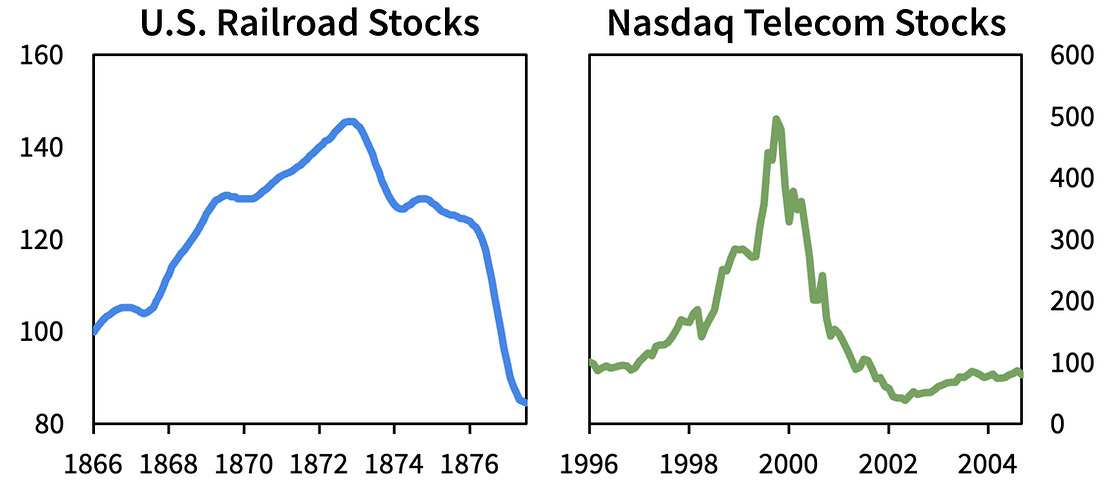
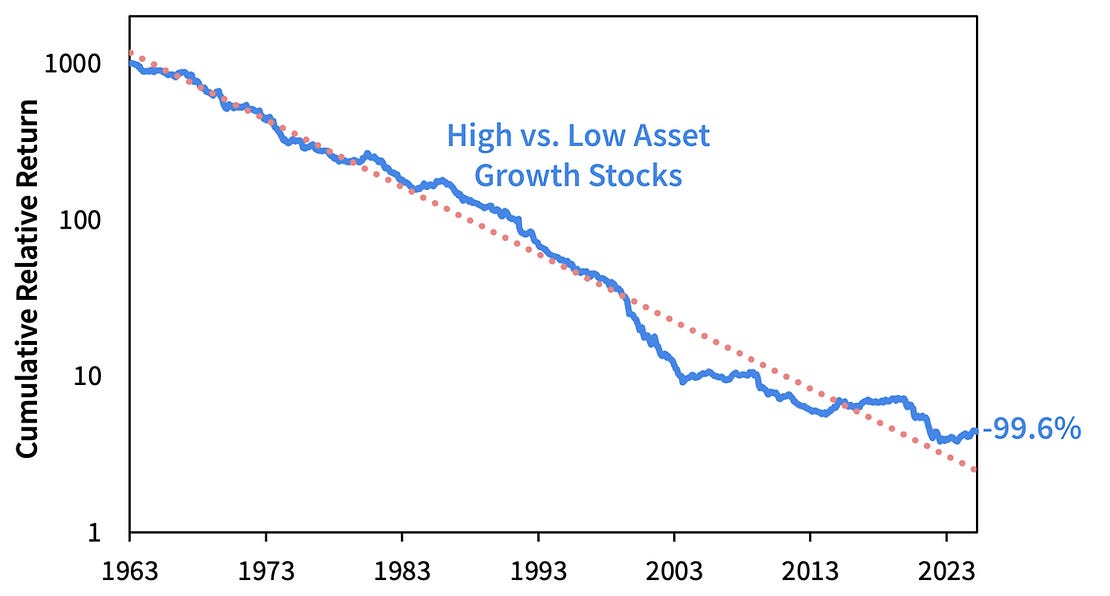
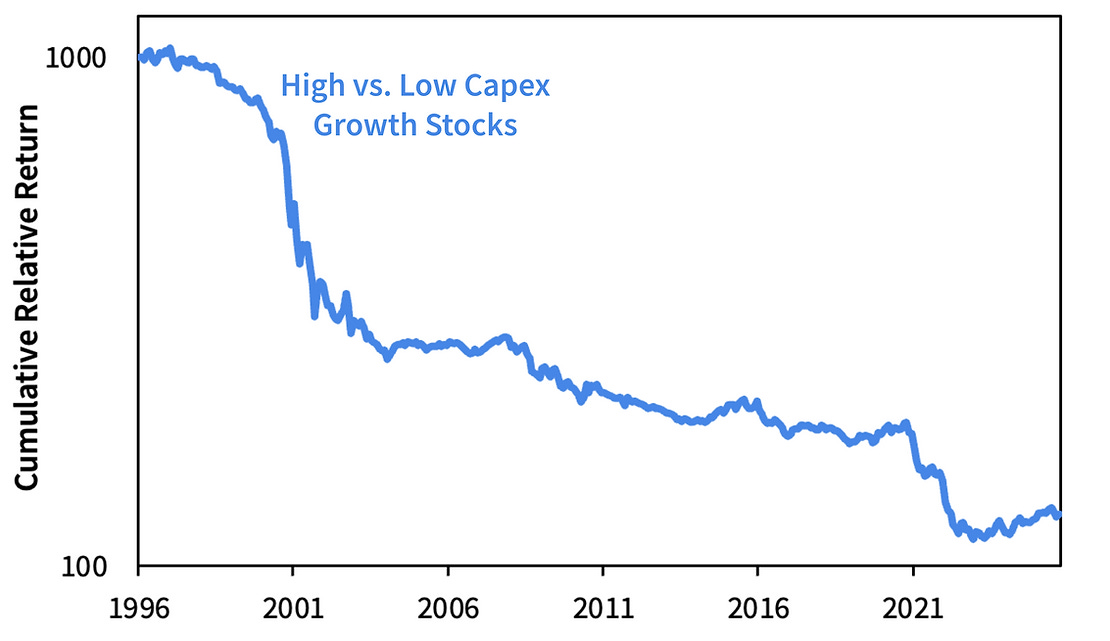
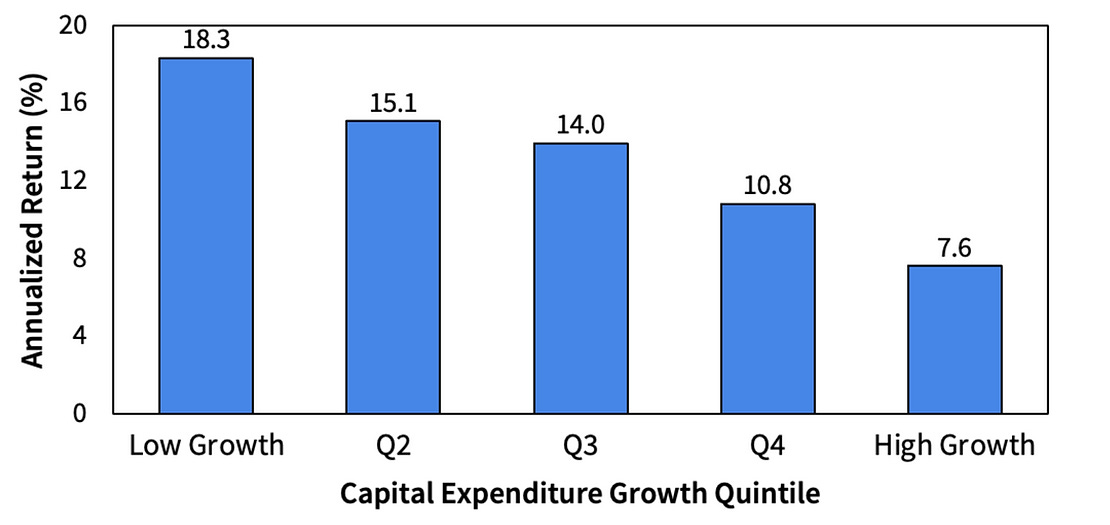

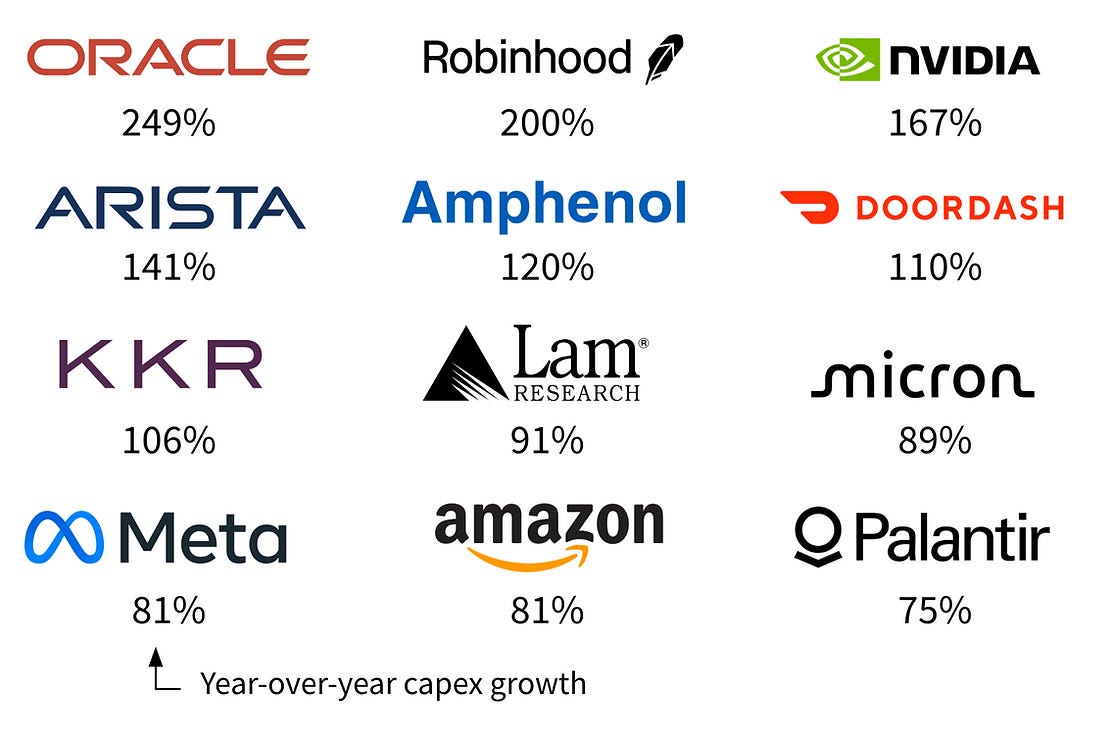



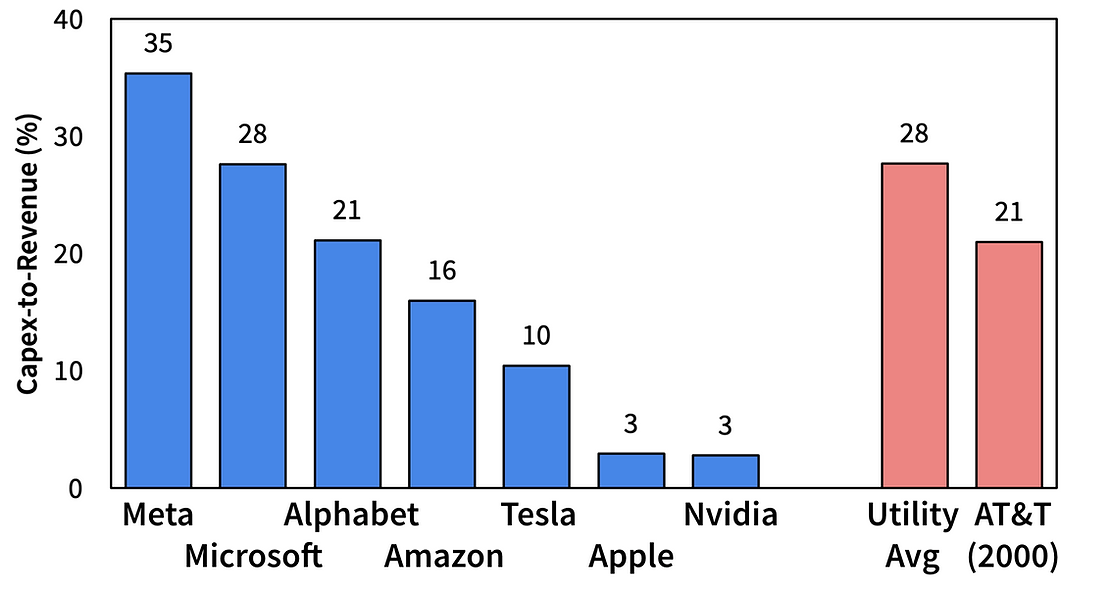

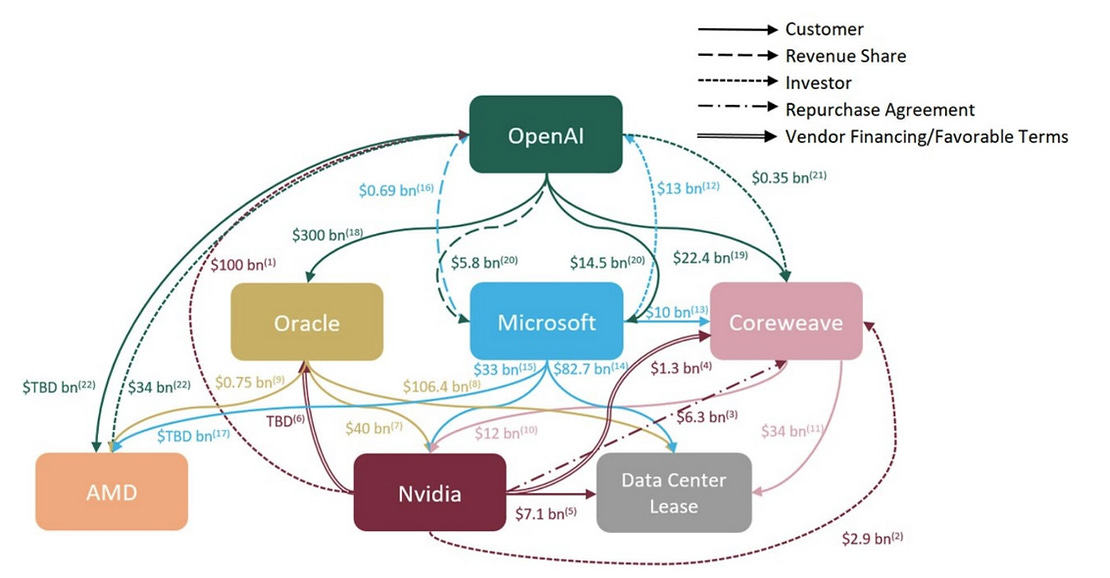
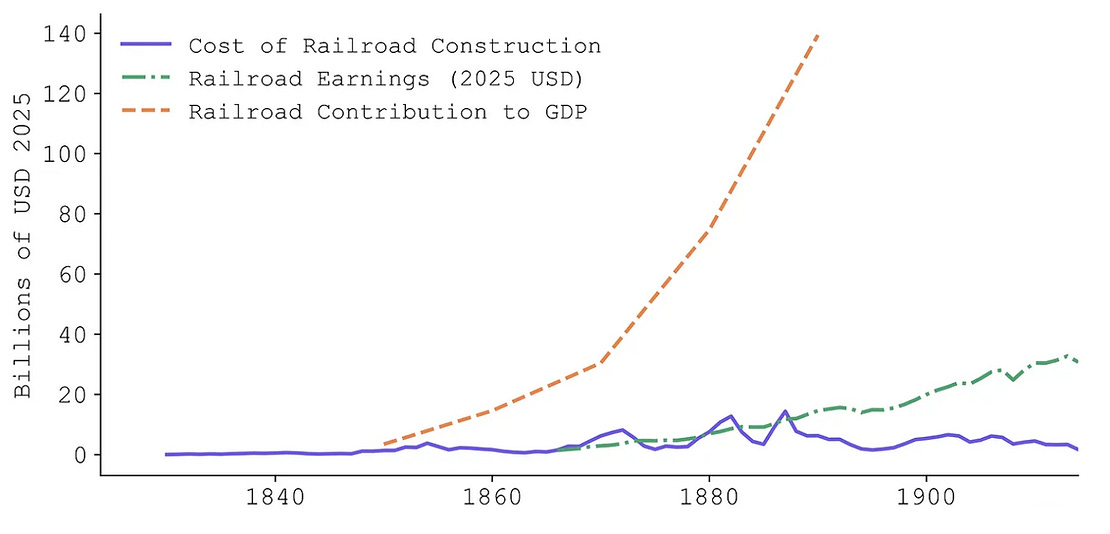
This is an absolutely phenomenal analysis of the AI capital spending cycle! The comparison to railroads and telecom bubbles is incredibly insightful. The stat that firms ramping capex have historically underperformed by -8.4% annually is eye-opening. What's particularly alarming is Meta, Microsoft, and Alphabet spending 21-35% of revenue on capex - more than utilities and even AT&T at the telecom bubble peak. The prisoner's dilema framework perfectly captures why the Magnificent 7 can't back down despite the obvious overinvestment risk. Your point about the real winners being the early adopters (like Netflix benefiting from cheap bandwidth) rather than infrastructure builders is brilliant. The circular financing deals with Nvidia-OpenAI are indeed eerily reminiscent of dot-com era excesses. Thanks for sharing Kai Wu's research - his intangible asset focus is exactly the right lens for valuing modern tech.